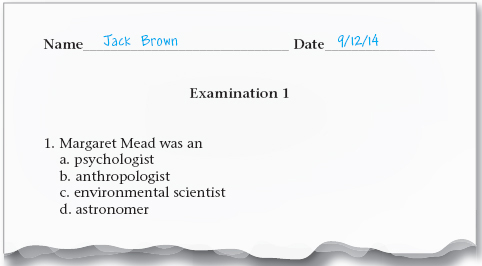Multiple-Choice Questions

Preparing for multiple-choice tests requires you to actively review all the material that has been covered in the course. Reciting from flash cards, summary sheets, mind maps, or the recall column in your lecture notes is a good way to review large amounts of material.
Take advantage of the many cues that multiple-choice questions contain. Careful reading of each item might uncover the correct answer. Always question choices that use absolute words such as always, never, and only. These choices are often (but not always) incorrect. Also, read carefully for terms such as not, except, and but that may be introduced before the choices. Often, the answer that is the most inclusive is correct. In general, options that do not agree grammatically with the first part of the item are incorrect. For instance, what answer could you rule out in the example in Figure 9.2?

YOUR TURN
Discuss
Many college instructors are reluctant to give essay exams in first-year courses and instead rely on multiple-choice exams. With one other classmate, discuss why you think that essay exams are less likely to be used in the first year than in later years. What kind of learning do multiple-choice exams measure, and what kind of learning do they miss? Share your reactions and ideas with the whole class.
Some students are easily confused by multiple-choice answers that sound alike. The best way to respond to a multiple-choice question is to read the first part of the item and then predict your own answer before reading the options. Choose the letter that corresponds to the option that best matches your prediction.
If you are totally confused by a question, place a check mark in the margin, leave it, and come back later, but always double-check that you are filling in the answer for the right question. Sometimes another question will provide a clue for a question that you are unsure about. If you have absolutely no idea, look for an answer that at least contains some shred of information. If there is no penalty for guessing, fill in an answer for every question, even if it is just a guess. If there is a penalty for guessing, don’t just choose an answer at random; leaving the answer blank might be a wiser choice.